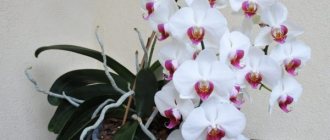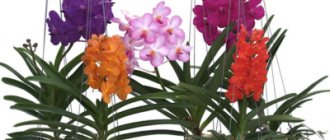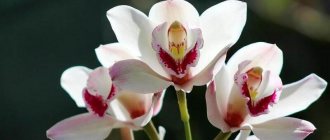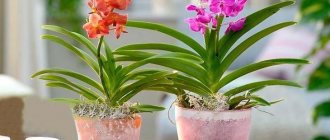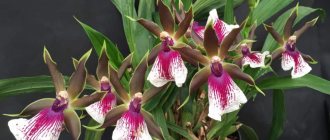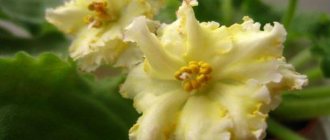Garden orchid, lovingly selected and carefully cared for, will be the pride of any gardener, delighting with spectacular and touching flowers for many years.
The key to success is
well-chosen :
- Landing place;
- Substrate;
- Lighting mode;
- Humidity and watering regime;
- Feeding;
- Wintering conditions.
Errors in at least one of these conditions can lead to failure of flowering and even death of the plant.
general description
Most of the orchid family is native to the tropics and subtropics. However, species are known that grow freely in temperate climates and even in Siberia. They, like some tropical varieties, became the founders of an ever-growing variety of garden orchids. The photo shows garden orchids.
Typically, garden orchids grow in warm places.
Today, no more than a dozen species of garden orchids are cultivated. Usually these are low, from 20 to 70 cm, herbaceous terrestrial plants, forming compact clumps with a superficial root system.
The leaves are green, less often striped, lanceolate or elongated, arranged alternately on the stem . Garden orchids grow abundant green mass, which distinguishes them from indoor species.
Asymmetrical flowers with a protruding lip, in some species they are collected in dense or very sparse inflorescences, racemes or spike-shaped. Others have one, rarely 2-3, flowers on their peduncles.
The coloring of the petals is varied , the palette is rich, the tones range from delicate pastels to richly saturated ones. There are orchids with plain, striped, spotted and speckled flowers.
Many hybrids have a subtle, pleasant aroma. Orchids often look like a butterfly due to their petals.
Why does the forest orchid grow poorly in the garden?
The main reason for the death of plants brought from the forest is considered to be the extinction of fungal spores, without which the development of the root system is impossible. A flower brought from the forest is alive until the fungal spores contained in the forest soil completely disappear. An orchid bush obtained by poaching is simply doomed to death in a home garden.
What to do if you really want to grow a perennial and frost-resistant orchid in your summer cottage? The answer is simple, you need to go to a nursery, where the hands of experienced gardeners and breeders have grown garden species of plants and, after that, plant them on your country plot, where they will be a wonderful decoration for many years. Although from the practice of experienced gardeners, we can conclude that nothing is impossible; creating a microclimate and soil mixture is perhaps just something you need to want.
Differences from tropical species
Like the luxurious tropicanas, garden orchids in domestic gardens stand out for their exoticism , non-classical touching beauty, traditional orchid flower shape and riot of colors.
However, there are noticeable differences :
- Tropical species live on trees, vines or rocky surfaces, using them as supports, and receiving water and nutrients from the moisture of precipitation and air , while almost all garden orchids are terrestrial plants;
- Garden orchids are more winter-hardy than those living in the tropics;
- Interspecific hybrids bred for gardens are less demanding on growing conditions : Lighting;
- Temperature conditions;
- Air and soil humidity;
- Plants - neighbors.
Story
The history of Nong Nooch began in 1954, when the Tansach couple acquired private ownership of a plot near the coast and the resort town of Pattaya. Mrs. Nong Nooch Tansach planned to create a garden with fruits here - coconut palms, mango, orange trees - and even began to implement her ideas.
But soon she went on a trip to Europe, where she was very inspired by the beautiful gardens of France, in particular Versailles. She couldn't wait to do something similar on her lands.
Versailles Palace and Park
By 1980, the work was completed and the park opened its gates to visitors. It reflects not only classic French landscapes, but also Italian ones and even the famous Stonehenge.
Since the beginning of the new century, the attraction has been managed by the couple’s son, Kampon Tansacha. He is considered one of the richest people on Thai soil.
Kampon Thansacha in Nong Nooch Park
It is Campon who owns the automobile collection, which is also exhibited as a separate area.
Nong Nooch receives about two thousand guests every day.
Features of growth in garden plots
Growing a garden orchid requires the attention of a florist . Although most popular species are not particularly picky, you still need to create certain conditions for the plant.
The best place for an exotic beauty in the garden is a place protected from the winds , in the openwork sliding penumbra of deciduous trees or conifers.
Garden orchids are best planted in places protected from the wind.
Other orchids, low ferns, grasses or hostas, and other non-aggressive plants that will not suppress the orchid, but will highlight its fragile grace, will be good partners in the flower garden.
Attention! Many wild orchids are listed in the Red Book and are protected by law. You should buy seedlings only from officially operating nurseries and flower centers.
Even a single planted orchid . As it grows, over time it will turn into a beautiful curtain. But the most luxurious unique option - a garden of different species and hybrids of orchids, alas, is not available to a large number of lovers of garden exotics due to the high cost of high-quality planting material.
Diseases and pests
Garden orchids are delicate plants and are susceptible to various diseases. The first sign that indicates a disease is reflected on the leaves. They begin to turn yellow or fall off. Reasons for this condition:
- When affected by anthracnose, yellowness appears along the edges of the leaf. Then it gradually spreads to the central part of the leaf blade. Excessive overfeeding with fertilizers manifests itself in the same way.
- With fungal infection, the leaves darken and become soft. In this case, the roots may be damaged.
- When powdery mildew appears, the leaves are treated with a solution of foundationazole.
Note! If the leaf turns yellow, then gradually turns brown and dries out, this is a natural process.
Wild orchid Tricyrtis
Spider mites, thrips, slugs, mealybugs are the main pests that attack garden crops. The use of special pesticides based on metaldehyde will help to quickly destroy them. Regardless of the landscape design, a bright orchid will decorate any garden. Tall specimens look great in a mixborder or against a green lawn. Low varieties decorate borders. The exotic flower coexists well with ferns, sedges and small conifers.
Popular varieties
The history of orchid breeding is relatively short. The first interspecific hybrid was obtained only in the middle of the 19th century. Due to the complex and lengthy process of obtaining viable offspring from parent plants, and then waiting for many years for flowering does not contribute to the rapid growth in the number of hybrid species and varieties.
Several types of garden orchids have gained popularity among fans of this elegant, but often capricious plant .
Fingerroot - Dactylorhiza
One of the most famous representatives of the orchid family is Fingerroot , or Fingerroot. This name is a direct Russian copy of the official botanical name of the genus - Dactylorhiza.
The genus of orchids received its name due to the structure of a fleshy, palmately divided tuber-root, growing in the shape of a human palm with outstretched fingers: from the Greek “dactylos” - finger, “riza” - root.
The palmate root orchid is sun-loving and does not like to dry out.
Every year, the old tuber, dark brown and wrinkled, gives up all its strength to the plant and dies. At this time, the second one grows and gains nutrients - a young, juicy, hard tuber, which is called tuberoid, and which will ensure the life of the plant for the next year.
Interesting! Fingerroots (Fingerroots) have only recently been isolated from the genus Orchis. They differ in the shape of the underground tuber; in Orchis it is ovoid, round, and resembles a nucleolus .
Perennial herbaceous palmate roots do not grow tall; their height is from 30 to 70 cm, rarely up to 1 meter. Form neat clumps.
The leaves are lanceolate or narrow, long, alternately sessile, usually solid green, but there are also species with clearly visible spots on the leaf blades. The straight, strong stem bears a dense multi-flowered inflorescence .
The flowers are asymmetrical, 1-3 cm in size, and have a characteristic structure :
- Three-lobed lip, flat, with a spur;
- And 2 petals and a sepal folded into a helmet.
The color ranges from white or soft pinkish in some varieties, to deep purple and deep purple in others. There are spots and streaks scattered on the petals, thanks to which the plant’s popular name “cuckoo’s tears” previously existed. They are distinguished by a special subtle aroma .
Almost all orchids of the genus Dactylorhiza prefer non-acidic soils, with the exception of Dactylorhiza sphagnicola (Sphagnum fingerroot), which must be planted in acidic soil flavored with peat.
Palm roots are sun-loving, need regular moisturizing , and do not like stagnation of moisture and drying out.
The range of these orchids is huge :
- Fingercorns live in temperate and cold climate regions of Asia and Europe;
- Grown in the north of European Russia: in the Urals;
- In Siberia;
- In the Far East.
They are undemanding in cultivation and are suitable for beginner lovers of exotics. They tolerate cold well; in extreme frost conditions, the stems are cut, leaving stumps up to 2 cm, and covered with spruce branches.
Tritsirtis
Garden orchids Tricyrtis (from the Greek “three tubercles”) are classified as members of the orchid family due to the unusual shape of the flower, but, in essence, this is a misunderstanding. In fact, the exotic-looking plant is a representative of the Liliaceae.
Tritsirtis orchid loves dark corners.
Its homeland is the forests of Southeast Asia, where it is also known as “toad lily”: its specific smell is attractive to edible amphibians.
The roots of the plant are located close to the soil surface and quickly recover when damaged. A low, 50-70 cm, herbaceous plant with long oblong leaves.
Flowers , like leaves:
- Speckled;
- Funnel-shaped;
- Or bell-shaped.
Petal coloring:
- Yellowish;
- Cream;
- Blue;
- Pinkish;
- Blue;
- Violet;
- White.
Flowers:
- Spotted;
- Sometimes pubescent;
- Very elegant.
The shape is intricate, size 3-4 cm. Six waxy curved petals with large teak and large stamens form a flower similar to a speckled “starfish”.
Typically, one bud is formed on each straight and strong stem, but a bunched arrangement is also found.
Tricitris easily takes root in shaded corners of the garden, well-lit by the sun for several hours a day, or in partial shade.
Soil is needed:
- Fertile;
- Slightly acidic or neutral reaction;
- Breathable;
- With high quality drainage.
When planting on poor soils, the following should be added to the planting hole :
- Rotted manure;
- Sand;
- Peat;
- Compost.
Tricitris will not be able to grow on heavy loam. Winter-hardy varieties tolerate winter well without additional shelter, but a layer of leaf litter or other mulch will protect Tricitris from unexpected cold snaps and will become a good organic fertilizer .
Advice! Tricitris does not like excess water, but is responsive to drip irrigation.
Of the two dozen species of Tricitris, due to their special winter hardiness, the following are widespread :
- Broad-leaved, the most unpretentious, growing above half a meter, with white flowers touched with green spots;
- Short-haired, up to one meter high, with long leaves, white-pink flowers with deep pink large speckles and long flowering;
- Slightly pubescent, low, with small racemose yellowish inflorescences.
Will decorate the gardens of the southern Asian and European parts of the country, where there is sufficient heat and precipitation .
Shoes
Shoes or Venus's Shoes. This common name refers to plants that have similar external characteristics, but belong to different genera of the orchid family :
- Cypripedium and Paphiopedilum;
- Less often - to the birth of Melsipedium;
- Phragmipedium and Selenipedium.
Garden Lady's Slipper.
According to another classification, all of the indicated botanical genera are included in the subfamily Cypripediaceae, and plants with the name Shoe should be classified only in the genus Paphiopedilum .
The lady's slipper has chosen areas with moderately cold and temperate climates. Grows great :
- In Western and southern Eastern Siberia;
- In the Middle Urals and the Far East;
- Found in the Volga-Kama and Verkhnedneprovsky botanical regions;
- In other regions, although he feels somewhat worse there.
The root system consists of a massive rhizome and thin roots and lies shallow. The stems are short, abundantly leafy. Leaves :
- Green;
- Veined;
- Lanceolate;
- Pointed.
Planting of flowers on stems is single, rarely 2-3 flowers on a peduncle. The flowers are usually large and varied in color. The color of the petals and lips is often different, sometimes contrasting, and in some species it changes during the flowering period. In color there are :
- spots;
- Eyeliners;
- Mottling;
- Strokes.
Attention! A characteristic feature of the flower is its voluminous, wide lip-sac extended forward, giving it the silhouette of an ancient shoe.
In favorable conditions, the plant multiplies quickly, forming large island clumps. Winter-hardy, hardy species. Additional shelter is not required , but mulching and spruce branches on the eve of a harsh winter will not hurt.
To place the Shoe, you should prefer a slightly shaded place where the sun shines for several hours a day. The tree trunks of tall deciduous trees and a garden in the northern or northeastern part of the house are suitable.
Shoes grow well in fertile, loose, light soil. They need sufficient moisture, effective drainage, and mulching with an organic substrate.
Several varieties of Bashmachki have become widespread in culture .
The shoe is real. One, rarely two graceful flowers crown a medium-length stem (about 40 cm). The flowers are medium sized, with deep brown spiral lateral petals framed by a yellow lip. Variations in color . Distributed in the middle zone.
Slipper grandiflora. The plant is strong, up to 35-40 cm high. Wide powerful leaves, flower :
- Large;
- Pinkish-raspberry shades;
- With a voluminous lip;
- Single.
Sometimes the colors of the lip and petals differ, but more often the color is uniform and even.
As a result of natural hybridization of these two species, the swollen shoe appeared. A stable species in cultivation with a single medium-sized flower. The shape of the flower is similar to the present slipper, but with smoother and wider petals, and the color almost completely repeats the colors of the grandiflora slipper.
Bletilla striata
Bletilla striata - Bletilla striata, also known as Bletilla hyacinth, is the most common species of the dozen Bletilla .
It prefers regions with mild climates and grows here in brightly lit areas. In hot areas, light shelter or open partial shade is needed. Can be grown in temperate climates , but will require effort to achieve regular flowering.
Bletilla striata 'Big Bob'.
Low herbaceous species, from 30 to no more than 70 cm in height. Feature :
- Pseudobulb roots;
- Most often completely underground;
- But sometimes they come to the surface.
Casting:
- Long;
- Folded;
- Large ones.
There are also pseudo-leaves , forming a pseudo-stem.
The flowers are very graceful, with a typical shape for orchids; they are collected in light, spike-shaped, loose inflorescences . Color:
- Pale lilac;
- Violet;
- White.
This orchid must be carefully protected from the winds, avoiding waterlogging and drying out. Therefore, you should carefully consider the choice of site :
- Place protected from winds;
- Well lit, with the possibility of shading;
- Properly arranged drainage;
- Non-calcified light loose soil, with a slightly acidic, neutral, or better yet slightly alkaline reaction.
Attention! Tender Bletilla needs to be watered very carefully so that drops of moisture do not fall on the flowers and leaves.
In areas with warm winters, the orchid is covered with dry foliage. If the temperature drops below 5 degrees, the tubers need to be dug up for the winter and stored in a cool, dry room .
Care
To successfully grow garden orchids you need to know a few general rules.
Landing
For planting orchids choose :
- Quiet, windless place;
- With good lighting, but in light partial shade.
In open sunny areas, it should be possible to shelter the plant from scorching rays on a hot day.
Soil characteristics are important for healthy development and abundant flowering. It should be :
- With good drainage and aeration;
- Neutral or slightly alkaline, rarely slightly acidic;
- Light and fertile.
Garden orchids love moisture, but do not tolerate stagnant water . A loose substrate is prepared for planting.
Place the following on the bottom of the prepared hole :
- Drainage from broken bricks;
- Peat;
- Large fraction of vermiculite;
- Pieces of pine bark;
- Sand;
- If necessary, rotted compost and manure.
Advice! If the soil in the garden is fertile and rich in humus, there is no need to add manure and compost.
An orchid seedling is placed on this hill and the roots are straightened. Carefully sprinkle with garden and forest soil and rotted litter, making sure that the buds are no deeper than 1 cm after the procedure is completed.
Gently crush and water with a small amount of water. When the soil settles, lay out the remaining substrate and mulch it with moss and pieces of bark on top.
Watering mode
Water orchids in the morning or evening , moistening the soil and trying not to wet the leaves and stems. In summer, water abundantly, but not in excess, so that moisture does not stagnate at the roots.
Attention! Orchids can more easily tolerate short-term drought than waterlogging and waterlogging of the soil.
During periods of frequent rainfall, watering is reduced and stopped in winter.
Application of fertilizing and fertilizers
Flower growers do not recommend overfeeding orchids. In many cases, it is enough to mulch the soil in the flower garden in a timely manner, then organic nutrients will flow gradually and in sufficient quantities.
If necessary, apply special fertilizers for orchids , which can be purchased in specialized stores.
Transfer
It is recommended to replant garden orchids no more than once every 4-5 years. Many species can grow in one place for 15-20 years.
If the plant feels bad in its old place or a new plant is purchased, you should select a site and prepare a hole and substrate, as when planting an orchid.
It is important to choose the right time for transplantation. For most species this is spring, April or May. But it’s better not to touch the Shoes until August.
A transplanted plant may find it difficult to take root in a new location. There is a risk of not waiting for flowering not only in the year of transplantation, but also in subsequent ones.
Activities to prepare for winter conditions
In areas with prolonged autumn rains, it makes sense to arrange a light, waterproof shelter so that precipitation does not wash out the high-lying roots of the orchid.
The stems of non-frost-resistant species are trimmed, leaving low stumps, and covered with spruce branches, dry leaves, lutrasil - depending on the weather conditions of the garden.
Winter-hardy species in areas with warm climates do not need to be covered . In the northern territories, orchids are also covered with spruce branches, litter, and rags.
Advantages of Frosch® Lady's slipper hybrids
Winter hardiness
These delightful cypripedium hybrids are perfect for growing in regions where summer temperatures typically do not exceed 30°C and winter temperatures below 5°C. Provided there is sufficient snow cover, they winter at temperatures down to –30°C. This means that Frosch® hybrids are ideal for the middle zone.
Lady's slipper Frosch®
Good growth and long life
The hybrid lady's slipper, bred by a German company, takes root well and will show off in your garden for decades. This became possible thanks to the technology of growing seedlings in open ground.
Lady's slipper Sabine Pastel
Quality seedlings
All Frosch® Cypripedium seedlings are grown from seeds. These are first-generation hybrids obtained from crossing species plants.
Lady's slipper Renate Mix
Proven 4-5 year old plants are available for sale. Michael Weinert's hybrids grow naturally in the unstable climate of Upper Bavaria without the use of pesticides. After several years of such “hardening”, buyers can be sure that the seedlings are strong, healthy, will take root well and will not cause trouble.
Features of flowering
While indoor orchids can bloom twice a year, garden orchids follow a different schedule.
Period
Most garden orchids bloom in spring and early summer , before the foliage of deciduous trees fully opens. However, there are species that bloom in the second half of summer and early autumn.
As a rule, the flowering period lasts from 1 to 2 months. Then comes the time of development of the green mass and root system, which is replaced by the autumn-winter dormant period.
How to achieve large flowers?
Garden species of orchids differ markedly in the size of the flower, characteristic of one or another representative of the orchids. To obtain high-quality flowering you need :
- Observe lighting conditions;
- Provide optimal humidity;
- Provide nutrients from fertile soil or through fertilizers.
The necessary conditions
An orchid pleases with regular flowering , if it is not disturbed by winds and drafts, there is enough moisture, but not in excess, and comfortable lighting is provided. If at least one condition is not met, flowering may not occur.
Effect of direct sunlight
Most orchids need direct sunlight, but not scorching rays, but morning or early afternoon.
The midday hot streams of the sun burn the leaves, stems, flowers, and dry out the soil. The orchid may stop blooming .
When is shading necessary?
According to experienced exotic lovers, in most cases shading is necessary :
- After the end of flowering for early flowering varieties;
- In sunny weather in all other cases.
The exception is some representatives of orchids. For example, Bletilla does not mind mild sunshine in a favorable climate.
Important Details
- Species that can survive winter still need help. To protect the flower from the cold, it is dug deeper with peat and wrapped in agrofibre. This decision will allow the beauty to survive without loss.
- Fertilizing garden orchids is carried out immediately after the end of the dormant period. You can use various complex means. The best solution would be to use humus and compost.
- After strengthening the orchid on the ground, the top layer of soil is sprinkled with pine bark, which will prevent the roots from overheating.
Garden orchids are the best exotic decoration for an outdoor greenhouse or garden. Their presence will add variety and uniqueness. The main thing is attention and proper care.
Features of reproduction
Amazing, spectacular orchids do not reproduce easily , which is why there are not so many of them in the gardens of lovers of exotic rarities.
Dividing the bush
It is easier to propagate these plants by dividing the bush. The procedure is usually carried out in the spring, the shoes are divided at the end of summer. I choose mature, developed and absolutely healthy plants.
The orchid is carefully removed from the loose soil by hand, and the rhizome is carefully divided into two or more parts. Each of them should have at least two, and preferably three, vegetative buds.
Then each part is planted in its place, proceeding in the same way as when planting a plant.
Seeds
Propagation of orchids by seeds in artificial conditions is a complex, labor-intensive, multi-year process.
In the first years, the development of the seedling takes place in close connection with special fungi. After some time, a struggle for survival begins between the symbiotes, many seedlings die. The surviving plants develop for another 4-5 years until the seedling can be planted in the ground. And only after another 4-6 years does the first flowering occur.
The work is carried out by specialists in breeding centers , under sterile conditions.
Seed propagation of orchids at home is unlikely.
general information
These plants bear the features of grace and lush flowering of all varieties of orchids, along with the ability to adapt to difficult conditions.
They differ from domestic species in the volume of greenery, which is much larger. The leaves are elongated, sinewy, and from the side they resemble the foliage of a lily of the valley. The location along the stem is the next one. The flowers are unusual and have a bizarre structure. They are asymmetrical, and the lip is strongly pushed forward. The color of the flowers is very diverse. There are 10 species that can live in gardens.
Species recommended for cultivation
Connoisseurs of spectacular orchids can please themselves by selecting species adapted to a specific region; perhaps, the gardener will be required to take all possible measures to create comfortable conditions for the colorful plant.
Most will take root in the Moscow region :
- Bashmachkov;
- Fingerroots;
- Orchis.
You will have to work hard on Tricitris . The gardens of the Urals will be decorated with winter-hardy varieties of Dactylorhiza and almost any of the Shoes. In the Southern Urals you should take care of humidity, in the Middle Urals you should take care of covering plants for the winter.
Frost-resistant
The most frost-resistant orchids are Shoes, Orchids, and Palmate-roots. Other species can be considered frost-resistant only in warmer habitats .
In landscape design
In landscape design, orchids are used to create accents and bright dominants. Low-growing species are suitable for original flower borders, and medium-sized plants are suitable for mixborders in shady gardens.
Buddhist landmarks
However, the main asset of the garden is the French Park. It resembles a Versailles garden with groves, neatly trimmed trees, and narrow paths winding between them. Everything in the landscape is symmetrical, ideal and well thought out.
The typical European look with fountains and sculptures is diluted with Asian architecture. There are ponds, wonderful Buddhist pagodas, and copies of famous Thai temples.
Against a backdrop of bright greenery, classic multi-stage red tile roofs with upturned ends and golden spiers rise. Below them are snow-white columns and stairs leading to the entrance.
A little further away there is a whole string of white stupas. They are distinguished by a clear cut, beautiful bas-reliefs and images of Buddhist deities.
Visitors can enter the pagodas to view the interior decoration or practice. Also in the French Garden there is a Wishing Bell, the ringing of which can be heard from afar.
The French park makes for the most beautiful photographs.
